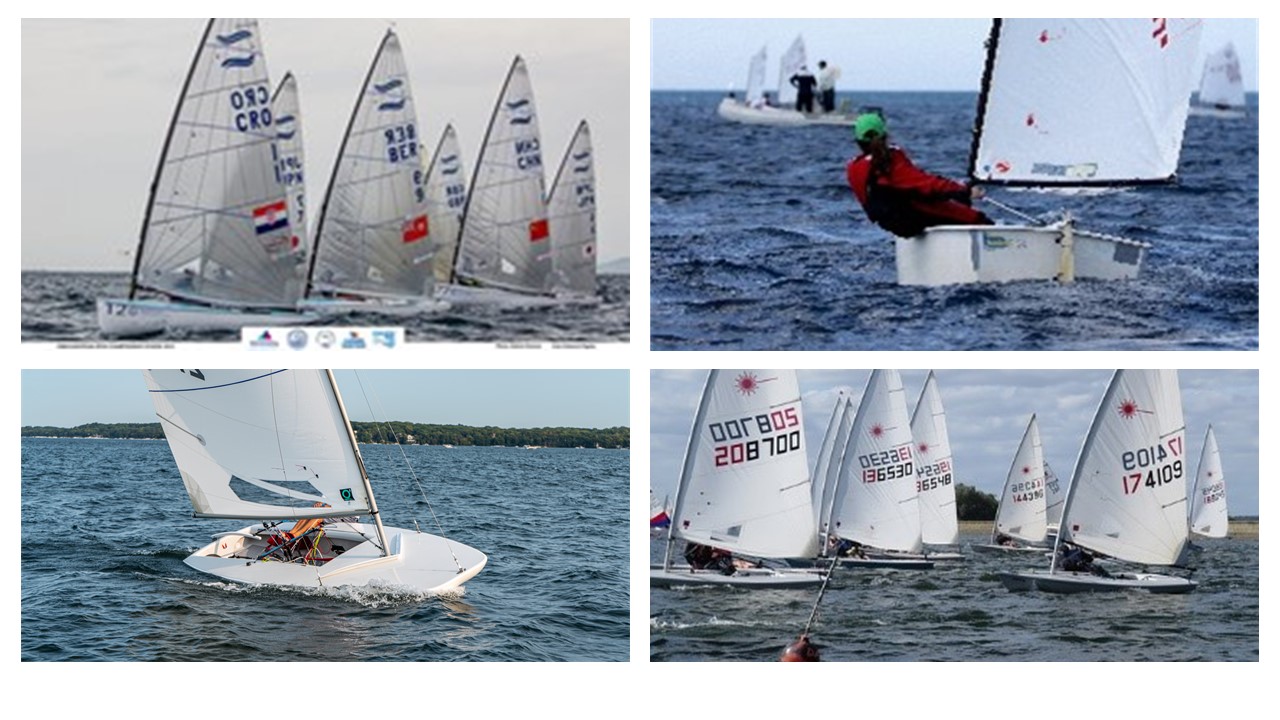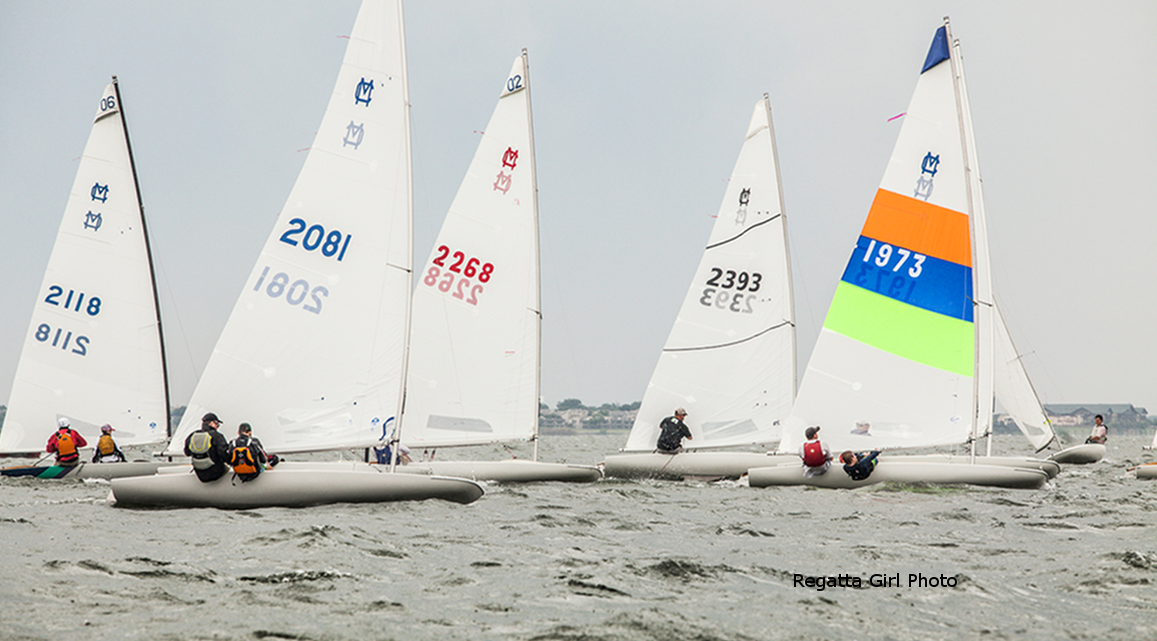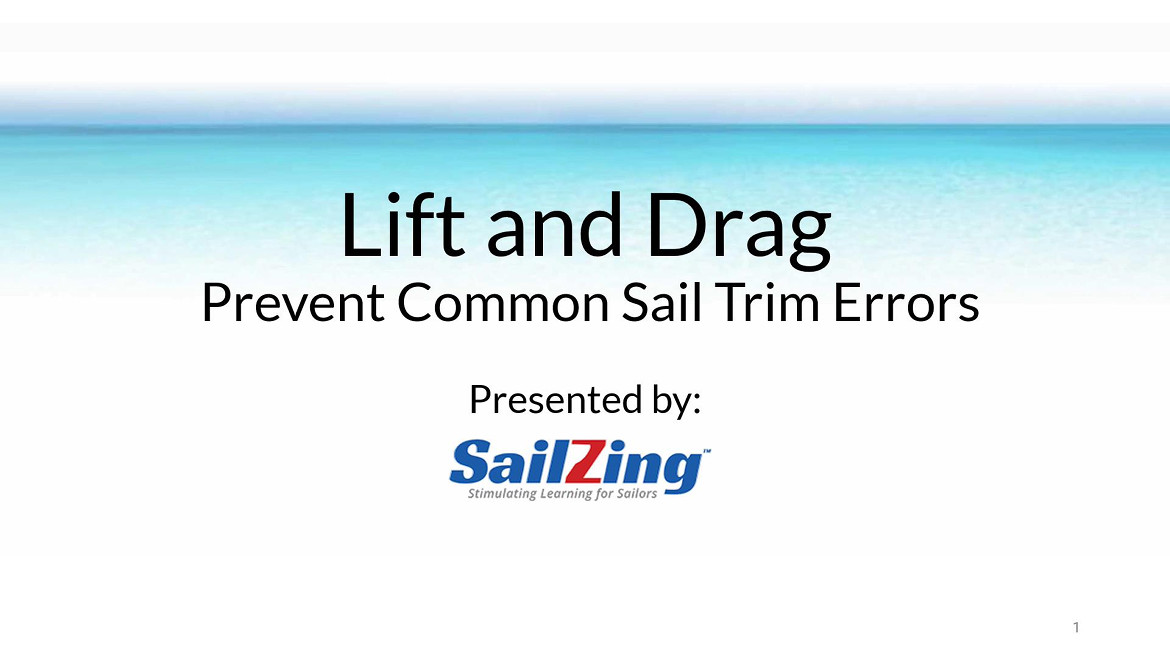Boats with only a mainsail (no jib), sometimes called cat-rigged boats, sail upwind with their boom further out than boats with jibs. Most of these main-only boats use “boom over the corner” as an initial trim reference. (The corner refers to the corner of the leeward rail and the transom.)
However, there are exceptions, particularly in the MC Scow class, where many sailors trim the boom much closer to the centerline in light-medium wind. The same is true to a slightly lesser degree in the C scow class. Take a look at the pictures below and see if you can spot this difference.

Could the MC and C scow classes improve their upwind performance by using boom over the corner as a starting point for sail trim? We got opinions from successful scow sailors, some of whom have also sailed other mainsail-only boats. We also reviewed the design, controls, and standard trim practices from various classes to identify any differences.
Boats without Jibs Need the Boom off Center
- With a jib, air flow is accelerated in slot, so the forward part of the mainsail has more lift. The combination of jib and main gives more forward force.
- Without a jib, there is no added acceleration and less lift from the forward part of the main. The maximum draft is designed to be 40-45% aft for efficiency. Thus, the total sail force is more to the side in a cat-rigged boat.
- Therefore, main-only boats need to have the boom off center to direct the sail force more forward.
Standard Trimming Practices
Standard trimming practices for mainsail-only boats differ based on design. This section compares several common designs.
Optimist
- No traveler
- Mast not very flexible
- Beginners are taught to start with the boom over the corner. Even as they become proficient, the boom rarely comes inside of the corner.
Finn
- Amidships traveler
- Flexible mast and controls for de-powering.
- Vang not effective upwind.
- Boom is never further in than the inner side deck, which is very narrow.
- After setting mainsheet tension, they set traveler based on boom position.
- Very light air, a little further out than over the corner.
- Light air – in slightly for twist.
- Drop traveler progressively as breeze builds. In heavy air, boom is outboard 4” – 8”.
Laser
- “Traveler” is a bridle that generally lets the block move to corner of the boat. By loosening the bridle, you can get the boom to move inboard but this is generally used only temporarily.
- Flexible mast.
- Vang helps bend mast upwind.
- Boom is rarely inside the corner. Sailors sometimes loosen the bridle or pull the boom block in manually for short periods if they want to point higher at the expense of speed.
C scow
- Rear traveler.
- Somewhat flexible mast, stiffness regulated by jack stays.
- Powerful vang that pulls down on boom.
- Sails have a large roach. The sail stalls easily in light-medium air if you try to pinch.
- Light air – start with traveler 4″- 6” to leeward and ease sheet so that boom is over corner. This gives some twist to the sail.
- Sheet harder as breeze builds to flatten sail and reduce twist. The boom comes inside the corner by a foot or more. Drop traveler more when becoming overpowered.
MC Scow
- Flexible mast.
- Amidships traveler.
- Powerful vang that bends mast directly.
- The tuning guides do not generally discuss boom position. A few guides mention easing the mainsheet to position the boom over the corner in light air.
- Tuning guides suggest keeping traveler on center and trimming to flatten sail and control leech.
- When you begin to become overpowered, flatten the sail first with the sail controls. Next, drop the traveler 1”. Drop traveler as much as 2-4” if breeze builds further.
Angle of Boom to Centerline with Boom Over the Corner
To make sure our class comparisons are valid, we estimated the angle of the boom relative to the centerline of the boat when the boom is over the corner. You can find this angle by measuring the distance from the mast to the center of the transom and the distance from the center of the transom to the corner.
Our figures are based on drawings from the classes discussed above. Here’s what we learned:
- All classes fell in the range of 7⁰ – 10⁰ off center when the boom is over the corner.
- The Laser, C, and MC were on the higher end of this range, while the Opti and Finn were on the lower end.
- This means that the scows might have the boom inside the corner (about 4”) and still match the Opti and Finn boom angle.
What do Scow Sailors Say About Boom over the Corner?
We interviewed several successful scow sailors on this topic. Some of these sailors had extensive experience in non-scow classes (e.g., the Finn) before jumping to the C or MC scows. Others had been life-long scow sailors. These successful sailors all trim using the standard parameters: angle of attack, camber, draft position, and twist.
The difference is that a few sailors also pay specific attention to boom position, and tend to want to keep the boom closer to the corner. In the scow classes, this means dropping the traveler earlier. Here are the key points and counterpoints in table form.
Point/Counterpoint – More or less Traveler
| Wind/Waves | Advocates for keeping traveler up | Advocates for dropping traveler earlier |
| Very light (sitting low), flat water | Traveler up promotes twist. Need twist and light sheet tension to open upper leech and retain flow. Twist is also important since wind direction may be different at top of sail. “Keep the leech open.” | By dropping traveler, can tension main or vang slightly to flatten sail and prevent separation of flow. A wide boom angle also lets you head down a little to promote flow. It may also compensate for a hooked leech. |
| Light-medium (sitting high or hiking), flat water | Keeping traveler up allows you to point 3-4 degrees higher. With no waves to slow you down, you will make better progress upwind. | Dropping traveler gives better forward speed and makes it easier to keep the boat moving in lulls. Added speed makes foils more effective for better progress to windward. Traveler down also reduces twist, which aids pointing. |
| Heavy with gusts, flatter water | Boom will be over the corner or further out. Use a tight vang and ease main to get boom out (vang sheeting). Traveler will be down, but not as much. In gusts, work main aggressively, easing and steering up slightly (feather) to keep boat on its lines. This approach opens the leech quickly when you ease. A tight vang also flattens the lower part of the sail. | Boom will be over the corner or further out. Traveler down more, with vang on, but not as tightly. Sheet the main very hard to keep sail flat. In gusts, ease and feather up. In this approach you will not have to ease as much in gusts, since there is less side force with traveler down. You will need to sheet very hard to flatten the sail with less vang. |
| Waves | All agree that the boom needs to be further out in waves for more driving force. This means dropping the traveler. Many sailors also use less vang in waves so they can bear off and ease the main without excessive helm. |
Key Take-Aways
- Boom over the corner is a rough reference. Don’t get hung up precision. Scows might have their boom 4″ or so in from the corner and still match the boom angle of Finns and Optis.
- Like any boat, scows need flow to go fast. Flow over the sails creates speed through the water, which creates flow over the foils.
- Different sailing styles can work. Many successful scow sailors can keep the boat moving in light-medium air with the boom well inside the corner. However, it’s easy to lose flow and hard to get it back.
- If you’re having trouble with boat speed and pointing, experiment with different styles of sailing. Try approaching boom over the corner sooner than you would normally.
- As sailors from other classes get more experience in the scows, time will tell if “boom over the corner” trimming becomes more prevalent.
SailZing Mainsail Trim Category
Heavy Air Boat Speed – Drop Traveler and Sheet Harder
Draheim Performance Perspectives – Drop the Traveler (jump to 01:35 for this topic)




